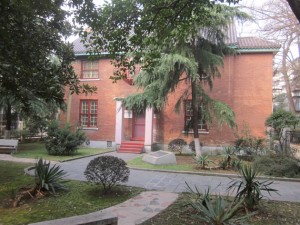Given that Changsha was original stomping grounds of Mao Zedong, you might think that the “Red House” — my abode here — is connected to his life and legacy. But not so. Mao never slept here.
But the house has its history. It was built in 1914, by Yale University, which established the Xiangya Medical School here in 1902, one of the first Western medical schools in China (and still one of the best.) The house is designed with about six suites, all sharing common sitting room, library, kitchen and laundry room. It is a two-storey, red brick structure that would not at all be out of place in fin-de-siecle New Haven. External brick and internal (wooden!) floors and staircase all painted in classical porch-floor-brick-red lend a fitting name.
Surrounded by a wrought iron fence enclosing a small garden, the house sits in a small trough among the large, standing waves of gray-concrete, five-floor walk-ups which loom, threateningly, all around it. But it has survived nigh these hundred years, and hopefully will defy modernization projects still for years to come.
The city around it — Changsha means “long sands” — is bisected by the Xiang River, flowing northward where it joins the Yangtze. The city of seven million is capital of Hunan Province. That’s Hunan of spicy food and spicy politics fame. Settlement here has been documented for thousands of years, and it was already an important commercial city by the Qin dynasty in 210 b.c.e.
But it’s history in the last 150 years has not been so placid. It was beseiged by the holy warriors of the Taiping rebellion in 1852, bashed by Chiang Kai-Chek’s Kuomingtang in 1927 on suspicion – well grounded – of being a leftist stronghold, and incinerated by the Japanese in WWII.
 But the Red House has withstood everything.
But the Red House has withstood everything.
As I mentally raze the nondescript housing blocks around me, I wonder how I should replace them. What else here has endured all those terrible-hopeful years? And what of my predecessors here? Yalies to a man (undoubtedly), like the Bushes. I have to imagine them as principled, courageous men with useful skills. But I also have to imbue them with covert agenda, aggravations, animosities perhaps, like the physician in Somerset Maughan’s “Painted Veil”, certainly with the arrogance of thinking that in dispensing Western medicines to the Oriental sick they were also dispensing civilization to the uncivilized.
them with covert agenda, aggravations, animosities perhaps, like the physician in Somerset Maughan’s “Painted Veil”, certainly with the arrogance of thinking that in dispensing Western medicines to the Oriental sick they were also dispensing civilization to the uncivilized.
This Red House is a haunted house.
One response to “The Red House”
re Changsha “a leftist stronghold”
why was this? was it more of a “leftest stronghold” than other cities?
Did Chiang & the Japanese go after Changsha more than other cities and was this related to it being a “leftist stronghold”?
is it a “leftist stronghold” today?
What are present day residents’ aattotudes towards Mao?